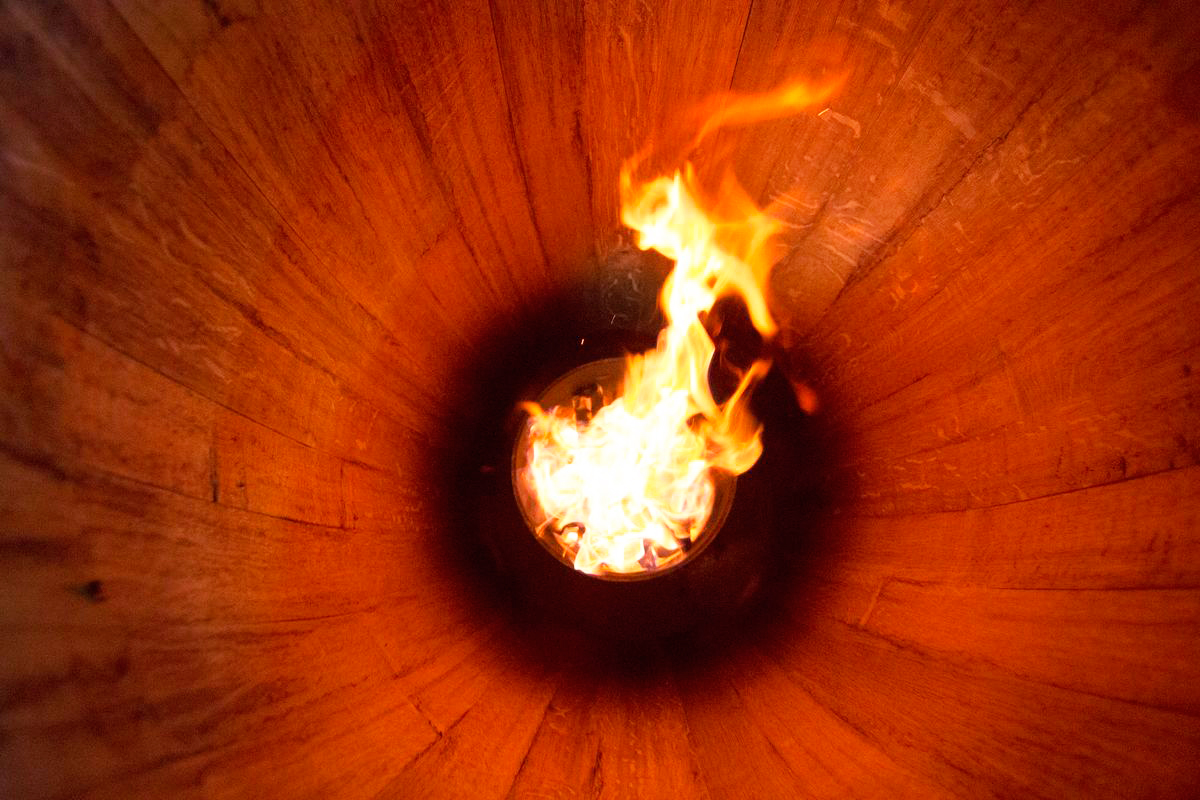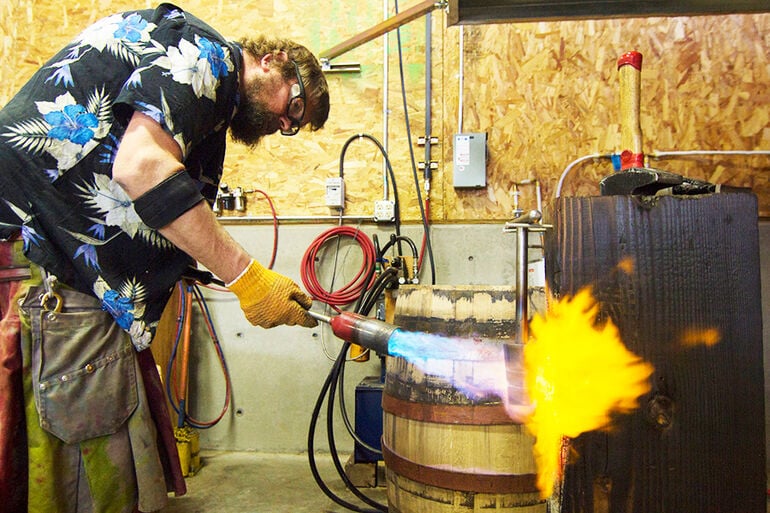Start 14-Day Trial Subscription
*No credit card required

The Role of Coopering in Barrel-Aged Beers
The Art of Coopering Part 1
At this point, wood-aged beers are far from obscurity. They are the Bender in The Breakfast Club of trending beer styles: brooding, powerful and often surprising in their character arcs throughout the aging process. For most, the flavors imparted from wood aging is where the line of focus is drawn. However, the path to wort on wood action is anything but dull, requiring expertise in an esoteric profession whose fate teeters on the brink of obsolescence.
The profession is coopering, which involves the creation of wooden, staved vessels held together with hoops and flat heads. Though the technological revolution has whittled it down to an oaken shell of its former industrial glory, coopering has found new life in the craft brewniverse, blending the line between art and science. Throughout upcoming issues, we’re going to pull the nail, open the bung and take a look at the intersection of wood, beer and the proud few who burn the torch of a bygone era.
So where’d this almighty vessel come from?
The earliest origins of the barrel are thought to have been natural, rather than man-made. The typical plot line of legend involves a hirsute ancestor stumbling upon a hollow tree stump full of rainwater. Recognizing its value as a storage container, it wouldn’t take a giant leap to slap an animal skin over the top, making a proto-barrel. In fact, Oregon-based Ale Apothecary has put this into practice, brewing a Nordic Sahti in a hollowed-out white spruce log lined with juniper.
What we know for sure is that the basis for the modern barrel evolved in northern Europe and Celtic territories between 1000 and 500 BCE, beginning as a simple wooden bucket and developing alongside the tools needed for more exacting craftsmanship; from early stone tools to bronze, then iron. Such tools allowed for pieces to be joined and eventually enclosed entirely, making for a more portable and shatter-proof container than the clay amphorae, which we know to have been used in conjunction with alcoholic beverages since at least 3000 BCE.

A barrel is hoisted at the famed Brasserie Cantillon, which brews lambics that are then aged and blended in barrels.
(Bottom Photo Courtesy Nicholas Landemard)
 As advances in technology go, the techniques used to make a ship seaworthy also applied to creating watertight barrels, and as our ability to sail improved, so did our barrel-making. It helped that the primary method of storage and transportation of goods was the barrel. By the Middle Ages, the barrel ruled, and would continue to do so until the early to mid-20th century, as steel and glass began to usher in a new era, relegating the barrel to part novelty, part antiquity; the flip-phone of containers. Today, around 2.5 million new barrels are produced each year, largely for alcoholic beverages. In the heyday of the barrel, the number was closer to 200 million, including wooden barrels used for oil.
As advances in technology go, the techniques used to make a ship seaworthy also applied to creating watertight barrels, and as our ability to sail improved, so did our barrel-making. It helped that the primary method of storage and transportation of goods was the barrel. By the Middle Ages, the barrel ruled, and would continue to do so until the early to mid-20th century, as steel and glass began to usher in a new era, relegating the barrel to part novelty, part antiquity; the flip-phone of containers. Today, around 2.5 million new barrels are produced each year, largely for alcoholic beverages. In the heyday of the barrel, the number was closer to 200 million, including wooden barrels used for oil.
But barrels refuse to go quietly. Wooden containers have long remained at the heart of the whiskey and wine industries, and beer has created an entirely new market for used barrels, and in some cases, new ones constructed specifically for the enhancement of beer.
Though there are no hard and fast rules, oak is the wood of choice for coopering, due to its strength, durability and the flavor characteristics it imparts.
What kind of wood is ideal for a beer-tight barrel? The short answer is oak, which is strong yet light, malleable and relatively impermeable compared to other woods due to its unique physiology. As a slow growing tree, an oak tree’s grains are tight and liquid-resistant. It can take anywhere from 80 to 300 years for an oak to be ready for harvest, with regulations in place to ensure sustainability. Oak also has a singular quality in that its sap channels, which initially allow nutrients to move through the tree, later fill with a material called tylose, essentially shoring up its conductive capillaries. The tree uses tylose as a mechanism for defense against rot and infection, but for the cooper it helps to create an ideal material. Oak also boasts extensive medullary rays, another form of protection and strength, which exists perpendicular to the tree’s rings. [1]
Oak is also a chemically pure wood that produces pleasant flavors ranging from coconut, sweet vanilla, clove, butterscotch, spice and smoke when heat-treated. While oak is the accepted industry standard, it’s by no means the only wood used to impart flavors to beer. There are many kinds of wood, and many species within each kind, some of which are more suited to wood-aging than others.
You may recognize cedar, cherry, chestnut, pecan, palo santo (most notably used in Dogfish Head’s Palo Santo Marron) and a host of others used to imbue all ranges of beers, wines and spirits with countless qualities of variable desirability. The intricacies of wood are myriad, and it takes a practiced hand to navigate them.
Like most trades, aspiring coopers learned through committed apprenticeships, usually for a period of seven years. Today, with modern machinery in the mix, the time period ranges from two to four years. The dedication required highlights certain traits that one must possess to even consider the work: patience, a desire and ability to work skillfully with the hands, as measurements can be as exact as one-two thousandth of an inch, and a finely tuned sensory palate – coopering is much more than placement of wood. Much of the work requires a trained nose to gauge the desired char of the barrel, or a keen eye to determine the worthiness of a stave.
The State of Coopering
A century ago, there were enough coopers to form unions, with the famed Bass Brewery in Burton-on-Trent employing 400 coopers alone. In fact, London’s cooper union was officially chartered all the way back in 1501, and was thought to have existed hundreds of years prior. Today, those numbers have dwindled to a fraction. In America, there are thought to be around 25 cooperages of varying size and purpose, and England is down to single digits. Recently, an article appeared in the UK’s Telegraph billing Alistair Simms, owner of White Rose Cooperage as England’s last “Master Cooper,” a title that took 14 years to achieve. Simms voiced his concerns about finding an apprentice to keep the tradition alive in today’s world. A similar article posted by the same publication ran in 2009 – no one’s taken the bait… yet.
Nevertheless, the practice lives on. Rodenbach keeps a cooper in-residence to maintain its giant foeders, which require an even further specialized knowledge, due to their size and delicacy. Generally, the construction of one foeder requires an entire team of “foudriers,” and can take weeks or months, depending on the size. If coopers are skilled builders, then foudriers are architects. We’ll take a closer look at foeders later on.
 The majority of coopering in America is focused on whiskey and winemaking. Thus, the strongholds of Kentucky and Tennessee produce many of the barrels that are purchased second hand for use with beer, while California boasts the largest number of wine-focused barrelmakers. Production aside, the industry that remains also sees a focus on maintenance, with some businesses solely devoted to barrel repair, while others act as brokerages, acquiring and often maintaining barrels from all over the world. Were you to desire a Portuguese chestnut barrel used for wine, such brokerages would be a good place to start.
The majority of coopering in America is focused on whiskey and winemaking. Thus, the strongholds of Kentucky and Tennessee produce many of the barrels that are purchased second hand for use with beer, while California boasts the largest number of wine-focused barrelmakers. Production aside, the industry that remains also sees a focus on maintenance, with some businesses solely devoted to barrel repair, while others act as brokerages, acquiring and often maintaining barrels from all over the world. Were you to desire a Portuguese chestnut barrel used for wine, such brokerages would be a good place to start.
When barrels aren’t available, which is a common problem due to the many limitations faced by modern coopers amidst heavy demand, alternatives include wood chips, often soaked in a spirit, or specifically designed wooden contraptions designed to maximize contact with the liquid and impart flavor rapidly. Minnesota’s Black Swan cooperage, a family-owned operation, offers a patent-pending “Honey Comb Barrel Alternative” (pictured) in nine different wood “flavors.” Sassafras, for example, will imbue your brew with notes of vanilla, mint, sage and root beer.
Wood use in beer isn’t always for flavor, though. Budweiser’s famed beechwood aging process imparts zero flavor, and they boil the wood specifically to ensure it’s as sterile as possible. Why use beechwood at all then? It helps create more surface area, which keeps the yeast active and working as quickly and efficiently as possible. The use of beechwood for this purpose was a common practice in the 19th century, and while it’s no longer technically necessary, it is tradition (and a nice marketing tactic).
It’s rare that you’ll find an all-inclusive cooper, engaged at every step of the process. In America, there’s only one that goes from sourcing wood to filling the barrel, Rogue’s Rolling Thunder Barrelworks.
Longtime employee Nate Lindquist fashions local Oregon White Oak into barrels by hand on vintage equipment. At max capacity, he cranks out one a day, indicative of both the attention to detail and level of specialization required in coopering.
After purchasing the equipment, Rogue President Brett Joyce had to find someone who had the necessary character traits to succeed as a cooper. With almost three decades of experience at Rogue, Nate was the first choice for the job.
“Nate has a lot of qualities that make him a good cooper,” said Joyce. “It takes brains – he's a smart guy, and it takes a real work ethic. Nobody in this company has a work ethic like Nate. You also have to be a little bit crazy to want to do it. It's an old school craft and you have to have the patience and passion, and you have to be mechanically inclined. It didn't take long to think about who might be able to pull this off. He's even got the look and personality.”

Lindquist determines the appropriate level of char with no tools, save for his senses – specifically sight and smell.
Lindquist, who isn’t averse to charring barrels in a kilt, packed his apprenticeship into a year at the nearby Oregon Barrelworks. By the end of his tenure, he was able to summon a barrel from a pile of staves – assembling, raising, toasting, charring, hooping, setting the heads, permanently hooping, cauterizing, sanding and branding each barrel. All in a day’s work.
“We’ve been making barrels for over a year now,” Joyce said. “It’s one of the best embodiments of our philosophy – Dare, Risk, Dream.”
Two years since the initial dream, Rolling Thunder Barrelworks is releasing its first beer – Rolling Thunder Imperial Stout. The barrels used for the stout were soaked for a year in Rogue Dead Guy Whiskey, and then filled with the stout, which features eight grains, Rogue Farms hops, brown sugar, sweet dark cherries, vanilla and chocolate. The beer is then aged six months in the barrels.
Coopering requires a bit of daring, plenty of monetary and physical risk between fires, brands and heavy machinery, and the vision to fashion a barrel of specific character from a piece of timber. And we’ve barely scratched the surface of this nearly forsaken art form.
Stay tuned next issue for a closer look at the processes involved in breathing life into a barrel, and the tools needed for the job.
Read The Art of Coopering Part 2: What Is a Foeder?
Read The Art of Coopering Part 3: How to Craft a Barrel

The "Eye of Sauron" leers up at the cooper during the barrel charring phase, which is integral to the flavors imparted during the aging of beer.
[1]Wood & Beer, Bouckaert and Cantwell, pgs. 41-42 (Photos Courtesy Rogue Ales except "Honeycomb" Photo via Black Swan Cooperage)




Comments